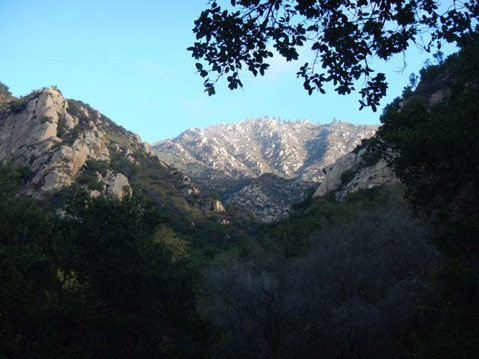Hiking with Children
A Review of Jeff Alt’s Book Get Your Kids Hiking

Book Review: Jeff Alt, Get Your Kids Hiking: How to Start Them Young and Keep it Fun! (Beaufort Books, 2013)
Maps: Ray Ford, A Hiker’s Guide to the Santa Barbara Front Country,; Bryan Conant, San Rafael Wilderness Trail Map Guide
In the dystopian 2008 Disney (Pixar) movie WALL-E the 1 percent of ruined earth’s survivors continuously orbit the planet enjoying a passive and sybaritic life of machine-enhanced ease. Like German philosopher Peter Sloterdijk writes about many in the modern EU, these tubby consumers openly choose to be agents “who are operated upon” rather than live as active participants in real-life.

Long before ever reading any of Richard Louv’s fine nature books, I had been taking my young son car-camping and day-hiking locally and in the Eastern Sierra. When he was three we moved up to an easy backpack along my favorite Manzana Creek in the nearby San Rafael Wilderness (inside Los Padres National Forest), walking slowly for 2.8 riparian miles to glorious Coldwater Camp [http://www.independent.com/news/2012/feb/18/coldwater-camp-dayhike/].
Now a working musician in Germany, I believe some of my son’s rhythmic and relaxed ways grew out of those significant chunks of “childhood time” he experienced in raw nature. In The Nature Principle, Louv metaphorically calls this special impact of wilder nature on young and old “Vitamin N.” Like many of us, Louv worries that most American children suffer from insufficient Vitamin N, which causes nature deficit syndrome (again, a metaphor).
Jeff Alt’s powerful new book, Get Your Kids Hiking: How to Start Them Young and Keep it Fun! speaks to the practical ways the reader can assist and inspire children to explore our remaining nature areas.
Whether you are a parent, an aunt or uncle, or a loving cousin–buy this book! Then get the maps, grab the kids, and head out to Rattlesnake Canyon or any of our other beautiful front-country trails (see Ford map) or parks. I recently saw young parents with babies in strollers making the circuit of the sloping Skofield Park lower parking lot–the babies’ eyes were full of delight and interest.
Where Alt gently notes how our technology-game obsessed children are losing out on the critical Vitamin N-rich nature experiences, and face the loss of face-face communication at school, other writers go much further in their indictment of screens. Philosopher Sloterdijk believes humans have already become part-android, and in 2010 he wrote evocatively about the (replicated) “image dominance” holding sway over human minds in the late 20th and early 21st centuries:
“Observations already show how humans come under pressure on two fronts at once: Not only have humans constituted a tiny minority compared to images for some time…they are also becoming a minority in relation to anthropomimetic cognition-mimetic machines, namely, computers.”
[You Must Change Your Life, p. 359]
We cannot prevent the dominant society and its myriad micro-machines from climbing into young human heads, however much we try to implant our own values and training. (I banned all TV from our home for more than a dozen years in this effort.) After teaching over 2,500 middle school age kids these past 34 years, and with enormous respect for all the obvious fine parenting they get, it still amazes how very much screens and social media dominate the entire family, but especially the young. We’re raising screenagers. Our kids’ minds have been media carpet-bombed with too much negativity, too many vivid (and often tormented) images, and too much palaver about war and suffering (e.g., the recent debates over killing humans in Syria).
Let’s suppose most readers of this column actually do want to take some young ones and drive to a nature spot, like the San Rafael Wilderness, for thinking and hiking, and refreshing the souls. Most of us who have children trapped in this image-driven passive “posthuman” society are aware of this technological dominance by design. Alt suggests a response that says go with the cultural flow: “including the latest gadgets related to hiking might make all the difference to your computer-savvy teen-agers” (p. 67), and then lists many micro-items that I’ll just label iClutter and iDistractions. My advice on student backpacks is to strip away as much of the tech as possible. While outside and away from the cars our brains aren’t distracted by the constantly alternating machine white noises, and we achieve a respite from the bane of our epoch: maintaining constant partial attention.
On a Sunday morning in September on Rattlesnake Canyon Trail, I encountered many adults, and their multitudinous dogs, but only a paltry few children. How can adults be so much better at bringing their canines to nature, but leave the children at home?
Alt’s book answers every conceivable query you might have, there just aren’t any excuses to sallying forth and having a great day in civilized nature (e.g., Alameda Park), or the more rugged front-country (e.g., Jesusita Trail or Rattlesnake Canyon), or eventually the raw world of the San Rafael Wilderness (47 mile drive from S.B.). Drive out past Ojai and crawl up Chorro Grande Springs Trail to 7,500 ft. Reyes Peak. Alt also offers 11 useful appendices that give you plenty of detail so you are ready to make sure your child has a great time outside with you. He has specific chapters for walking with toddlers, 3-4 years, 5-12 years, and teenagers. Since there are a lot of ins and outs to successful (= fun!) dayhiking/backpacking, really do utilize this book with its many lists.
The Wilderness Youth Project (WYP) is a local nonprofit that will work with your kids after school: see https://www.facebook.com/pages/Wilderness-Youth-Project/135466189884680 or view this WYP video http://vimeo.com/65913083 . Still, despite the fine work of WYP, Alt is correct that the best scenario is that you take the kids hiking and camping. Almost every Hiking the Backcountry column I’ve written for The Independent includes a reference to how suitable the described trail is for children, and recommended ages.
After 700 years aloft, the android Wall-E falls in love with a robotic Eve trash collector, which is like Ridley-Scott’s classic Blade Runner film where the android loves and the human is machine-like (based on the P.K. Dick’s prophetic short story Do Androids Dream of Electric Sheep?).
Can’t we lead our children into falling in love with the real thing, the Ding-an-sich, the thing-itself–our glorious mother Earth?? Obtain Alt’s book, look back at the preceding 31 Hiking the Backcountry hiking columns, plan, grab the kids, jump in the car, go to the trailhead and start hiking with joyful elan.
We can quote Friedrich Nietzsche, as Sloterdijk does, about increasing vigor and doing things overtly as opposed to have things done for us. Nietzsche writes, “Works first and foremost! That is to say, doing, doing, doing!”
Books mentioned: Peter Sloterdijk, You Must Change Your Life: On Anthropotechnics (Polity 2010, orig. German ed. 2009: Du muBt dein Leben aendern); Richard Louv, The Nature Principle (2011); Michael Adas, Dominance by Design (2009)



